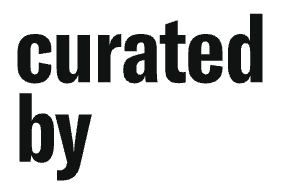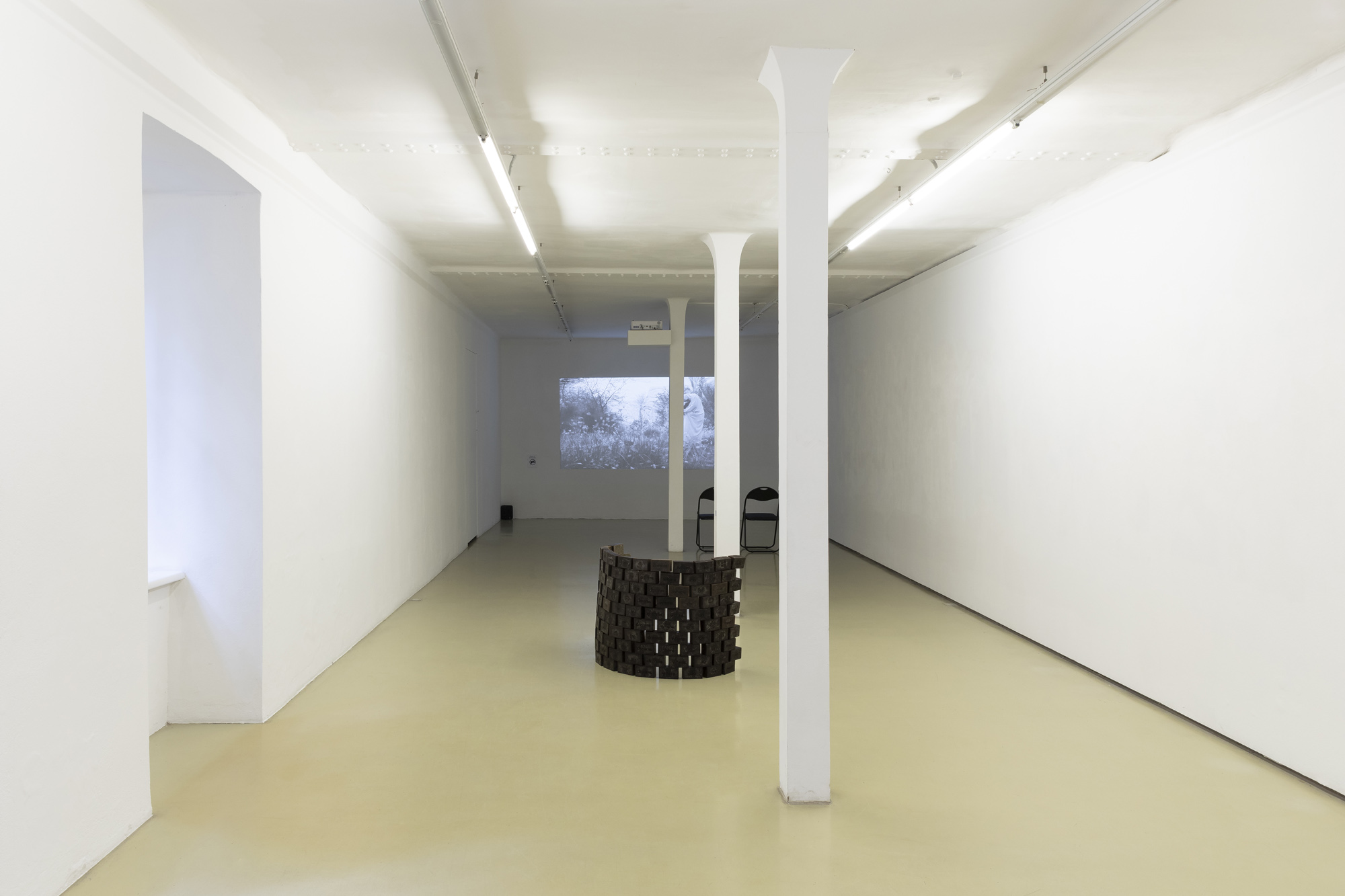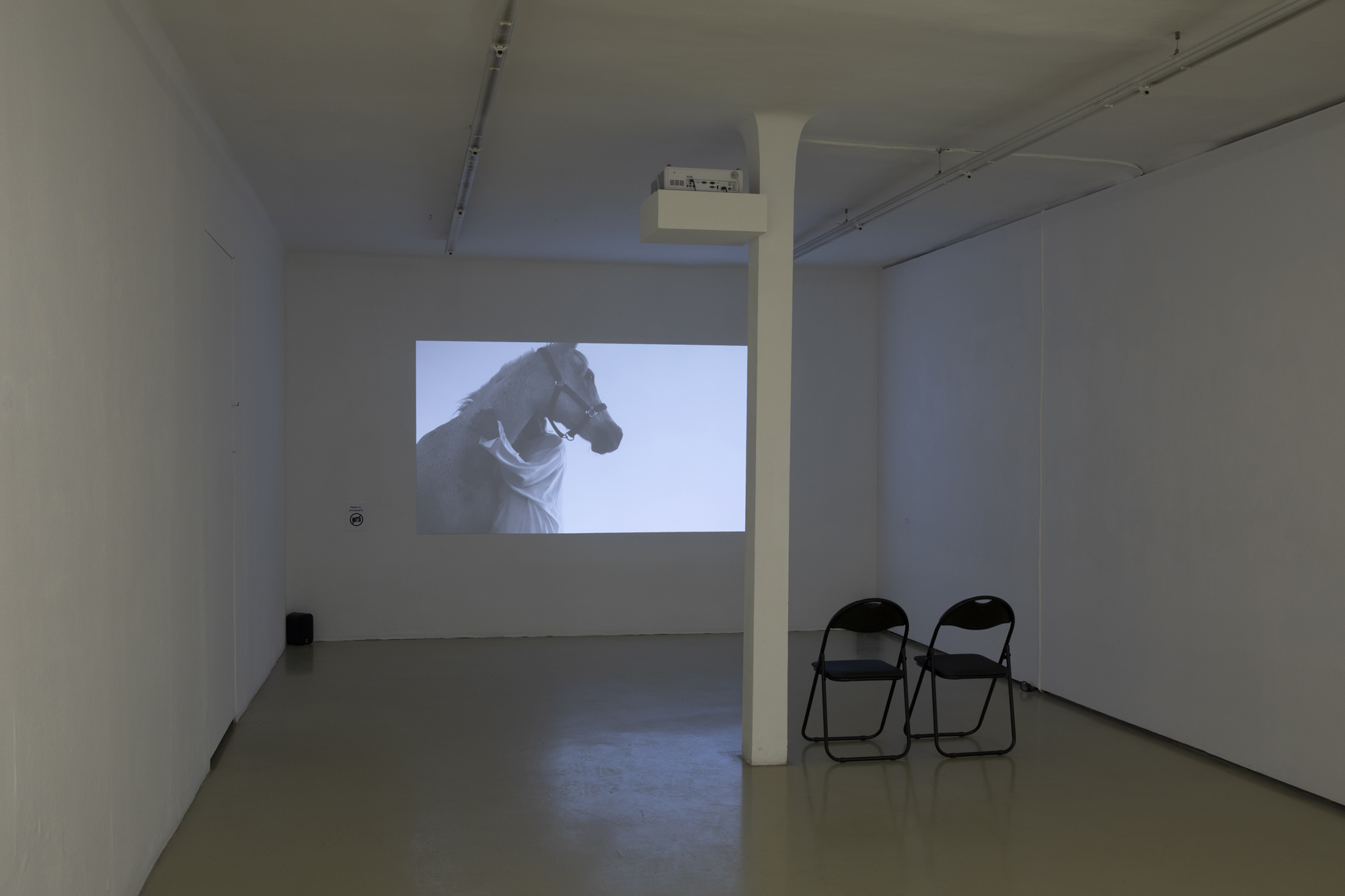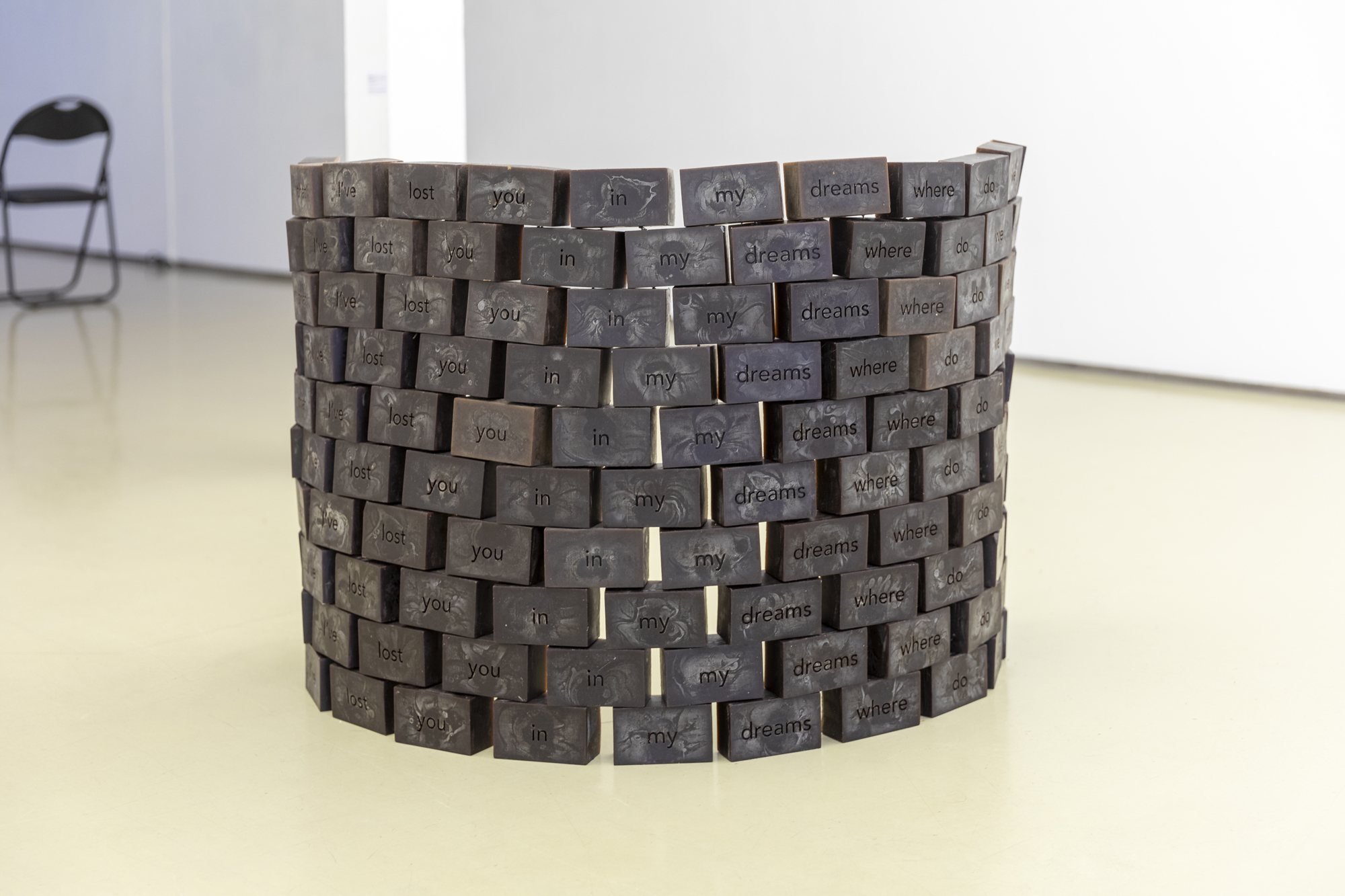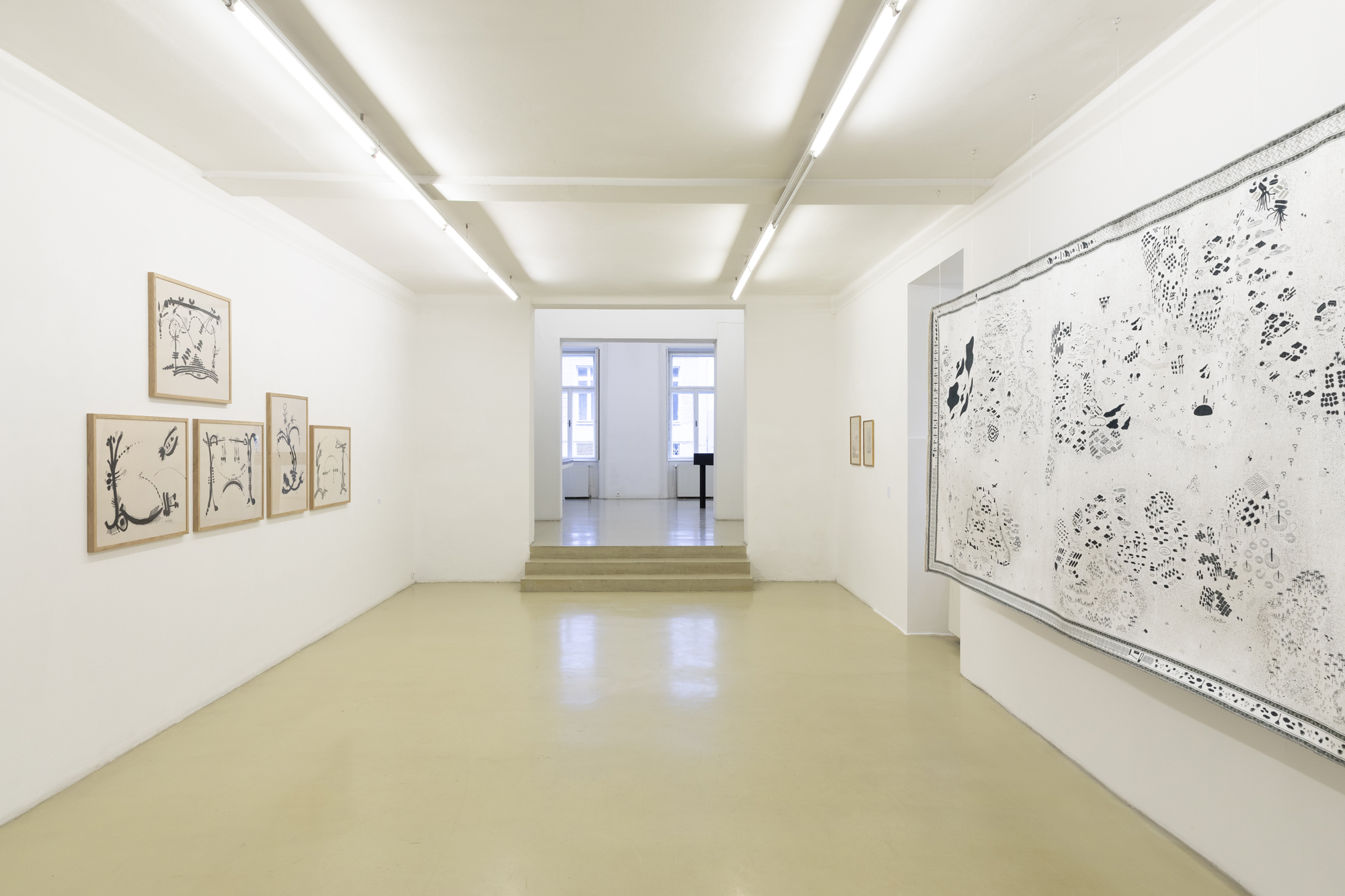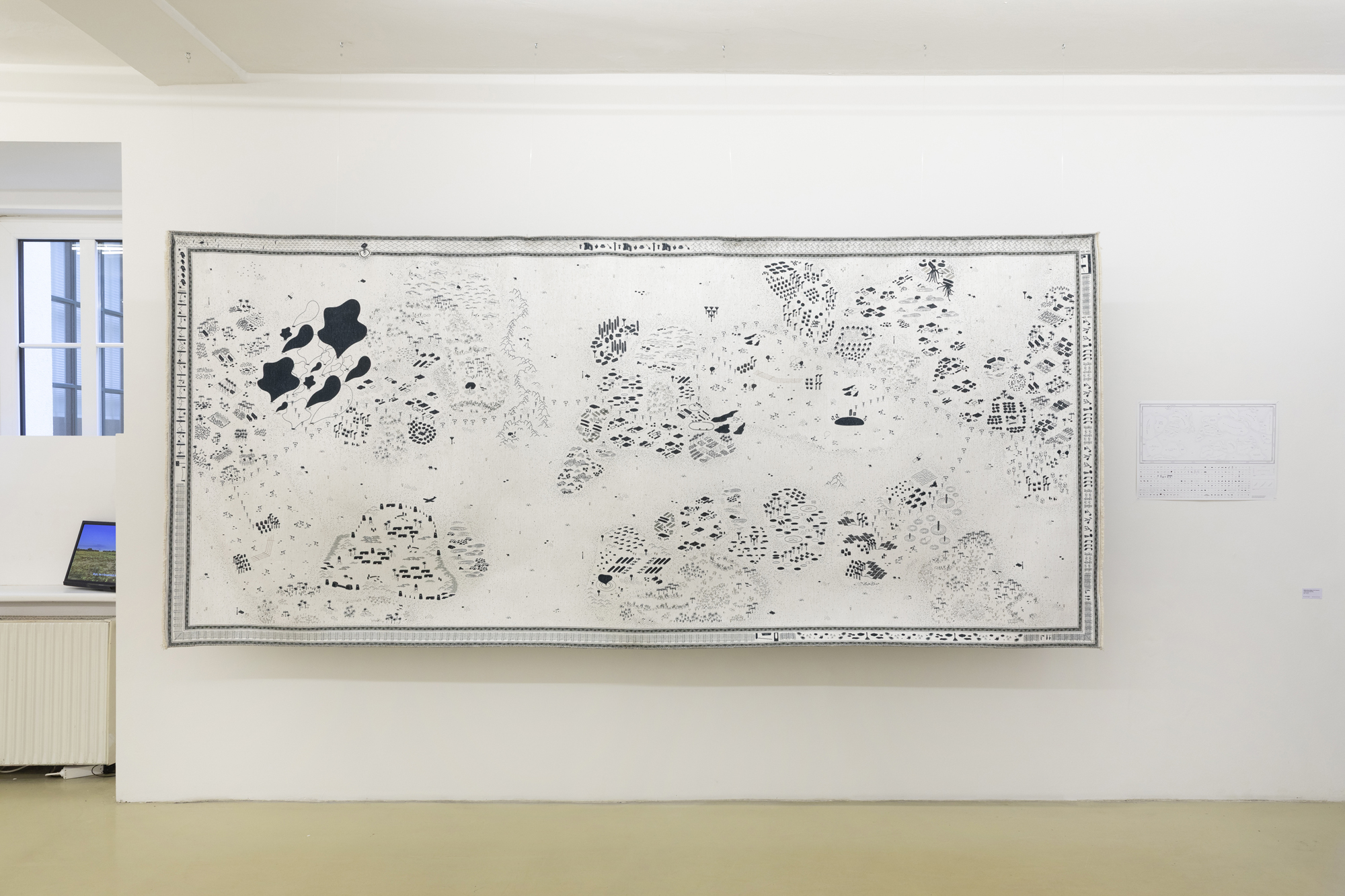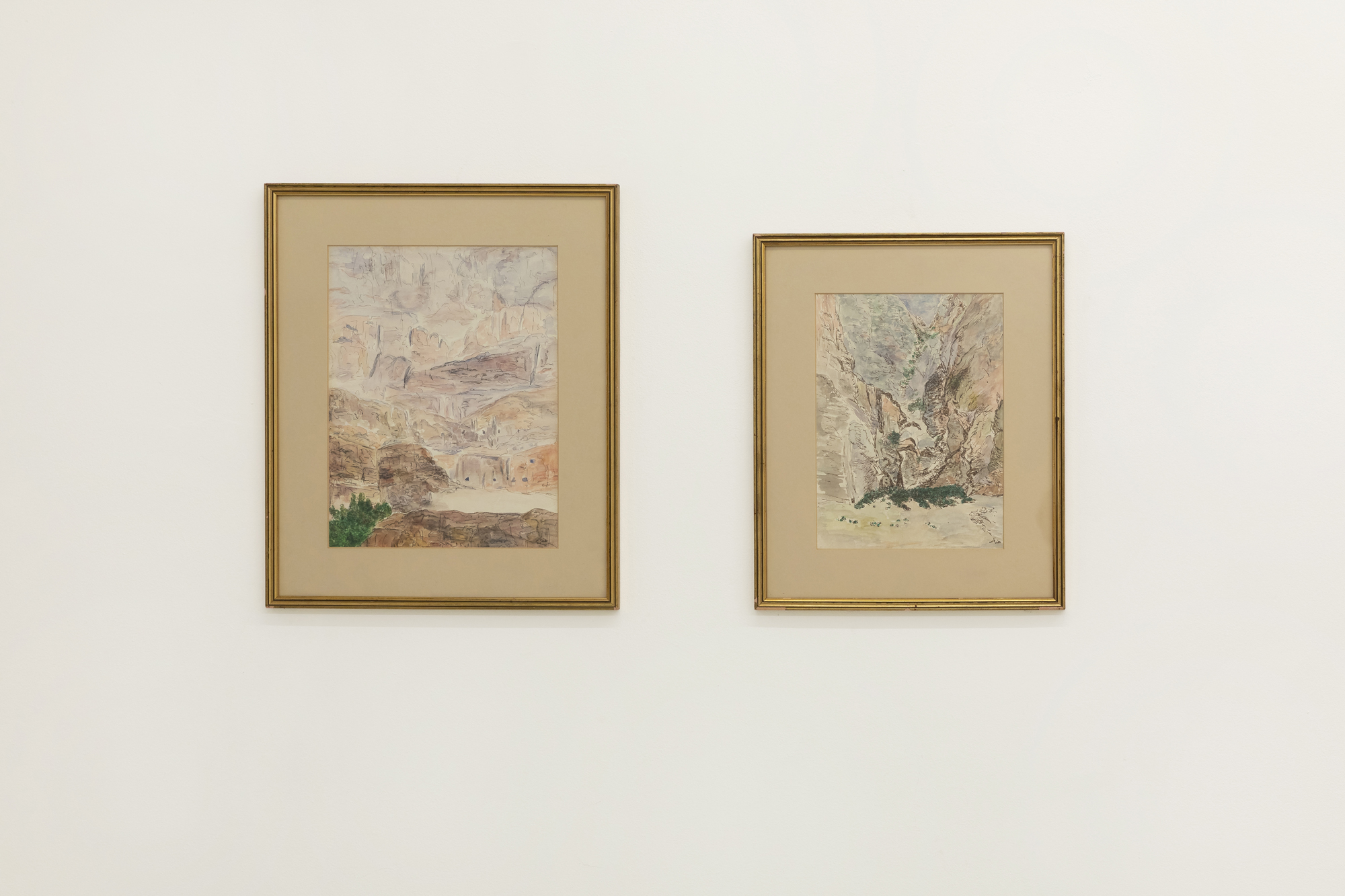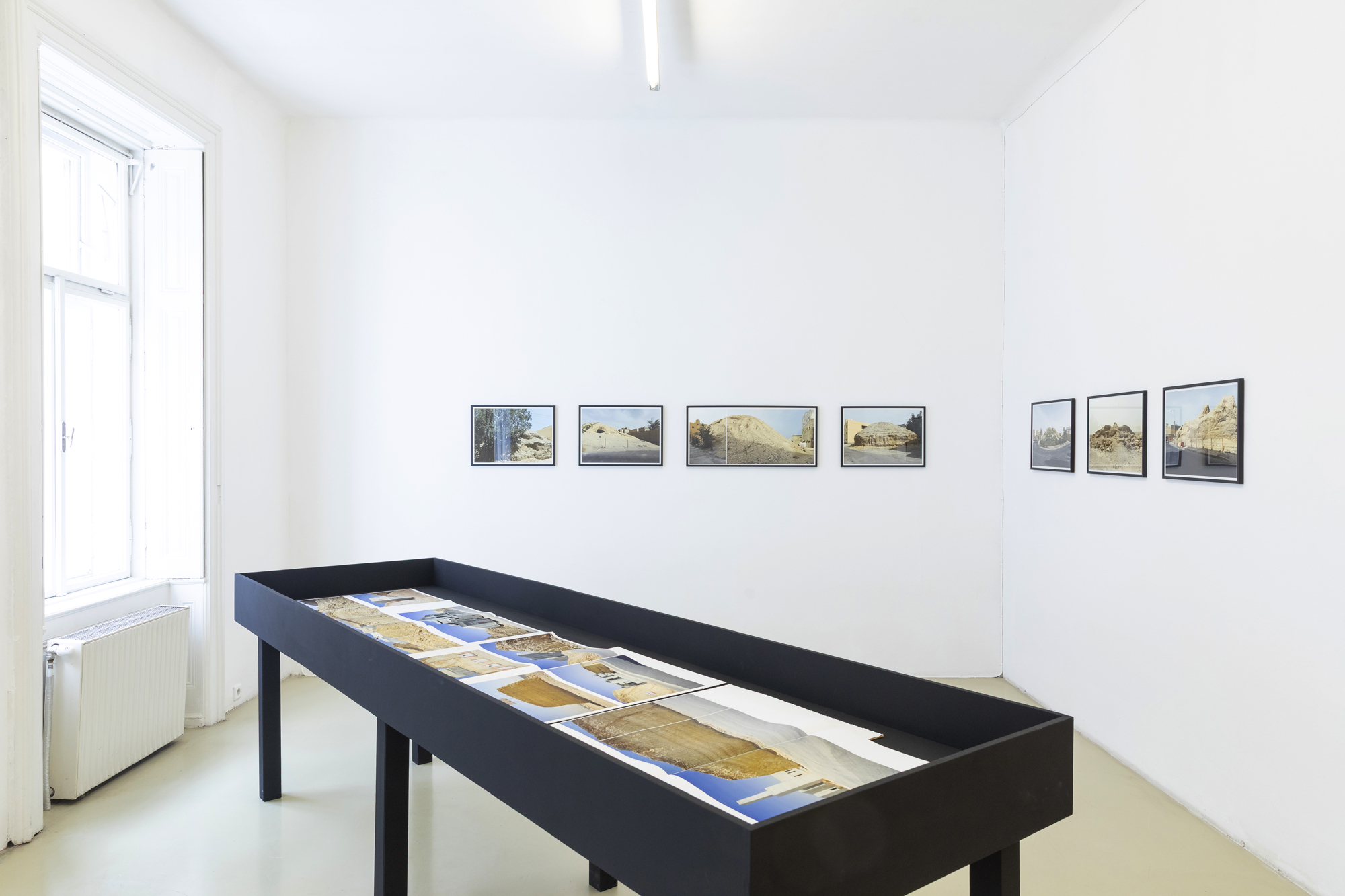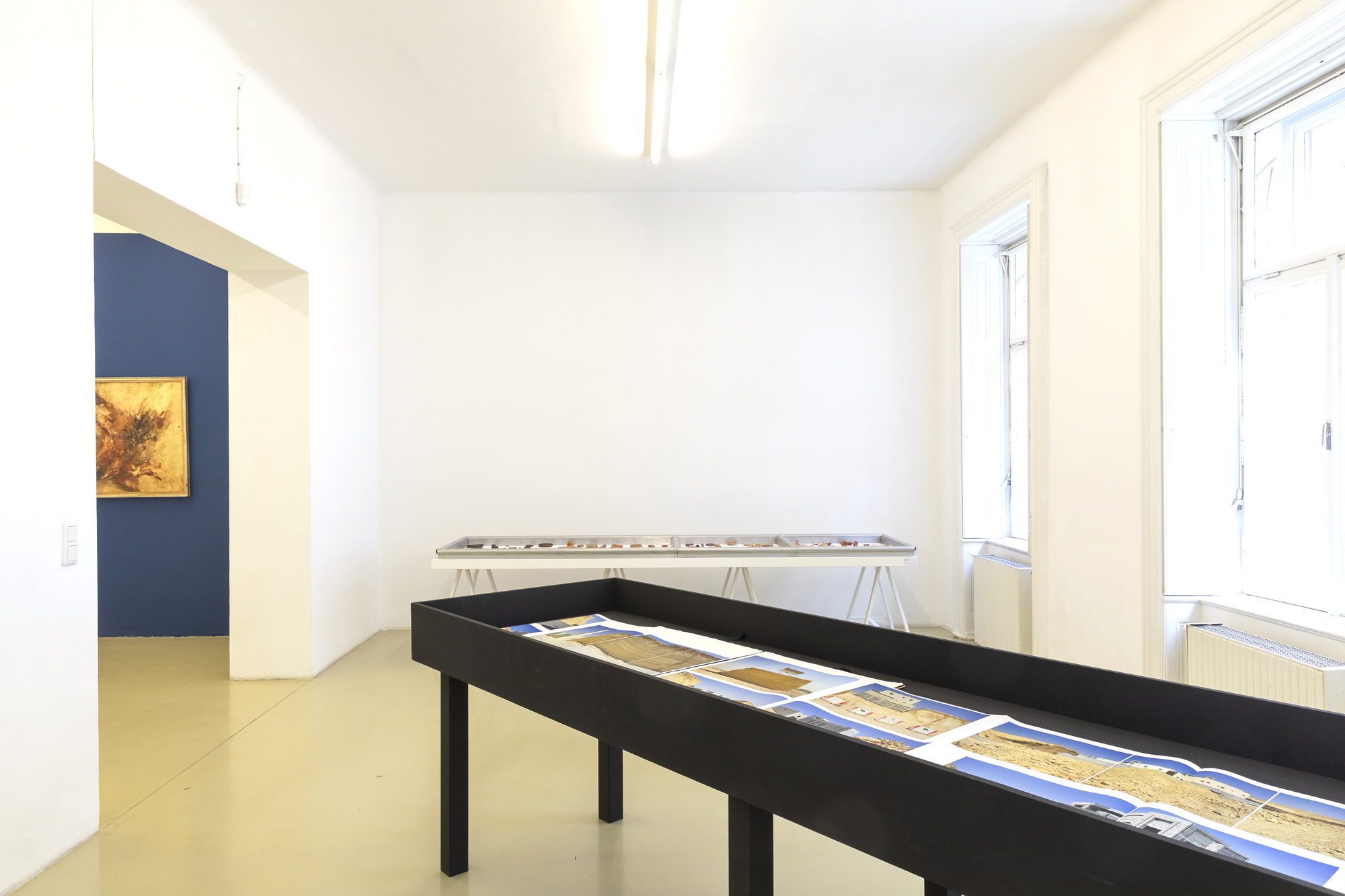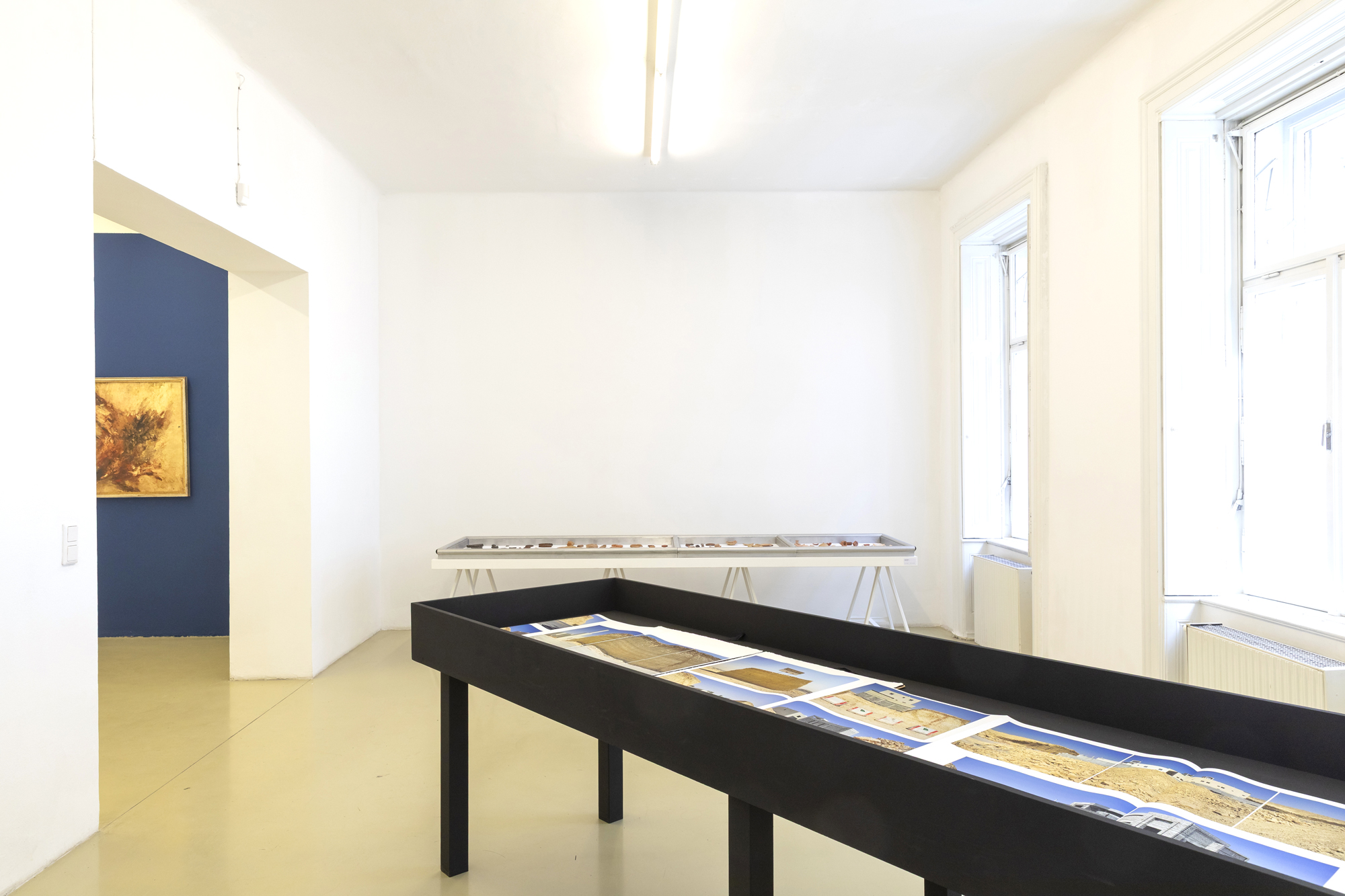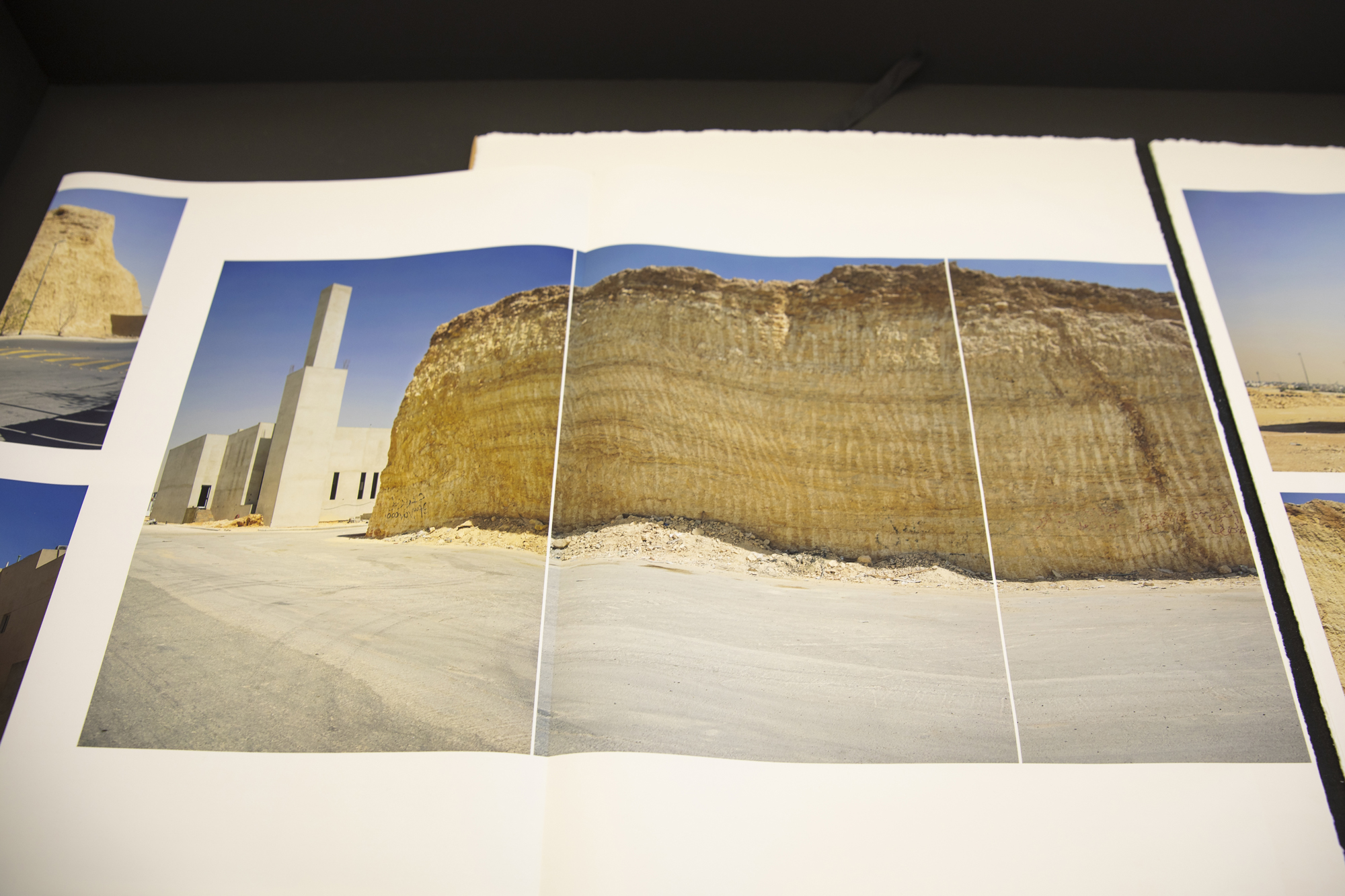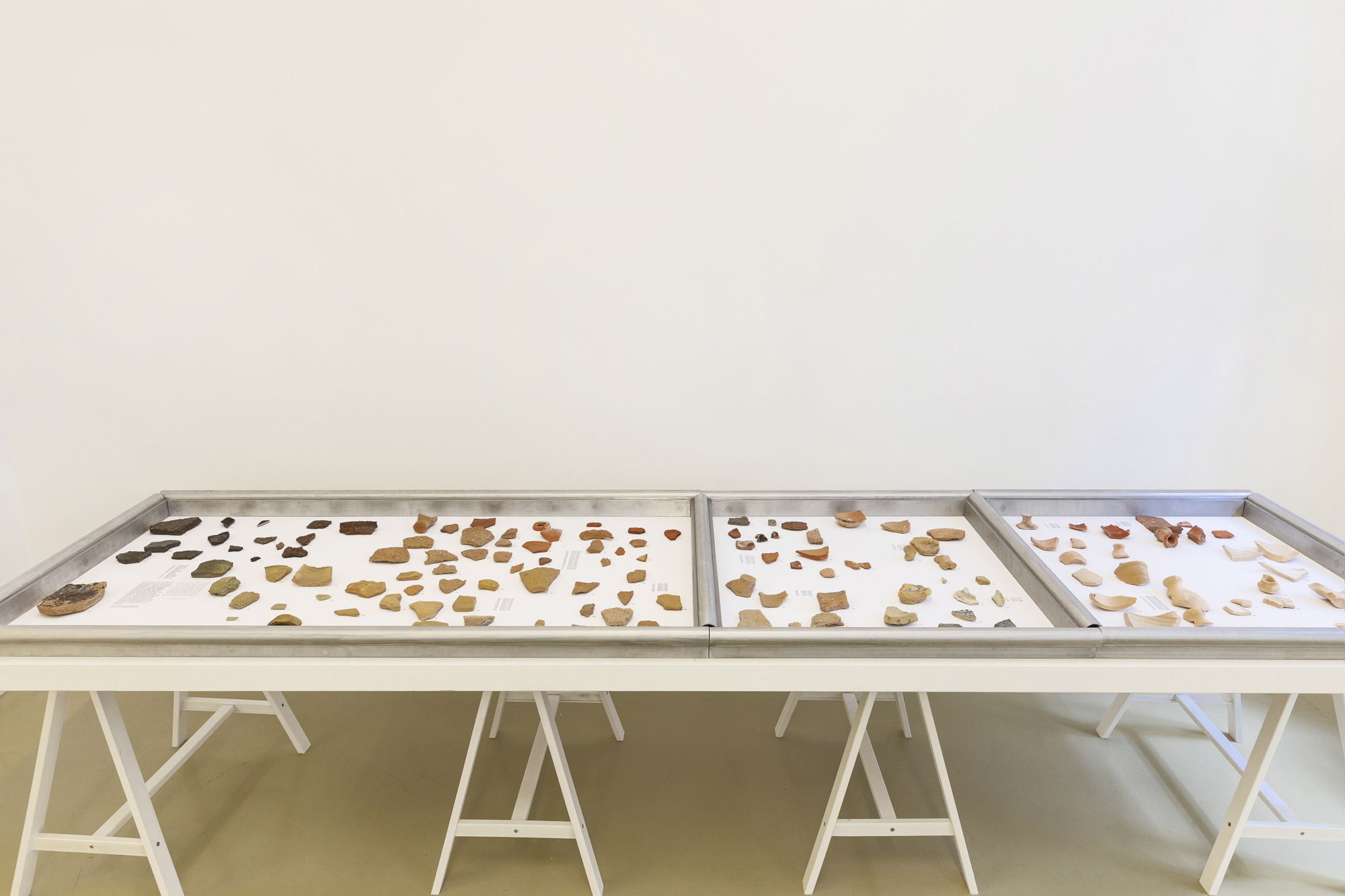Galerie Krinzinger & Krinzinger Schottenfeld curated by Ute Meta Bauer & Wejdan Reda
„The Desert Has No Shadow“

www.galerie-krinzinger.at
Curator(s):

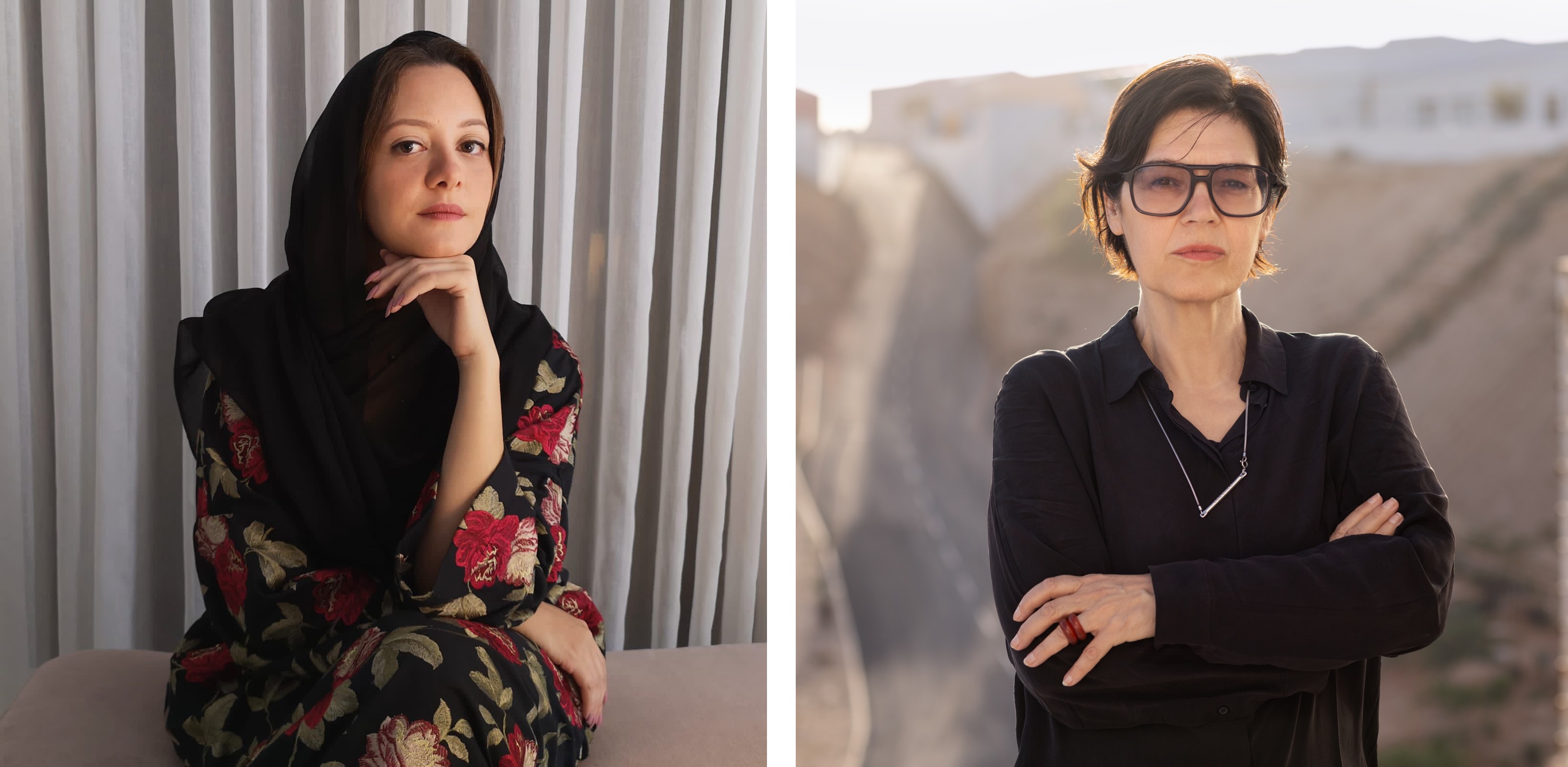
Artist(s):
-
Sara Abdu MoreAbdu’s illustrative practice of anthropomorphized melancholic figures held a preoccupation with the way human beings negotiate inner territories; often exploring themes of the self, memory, home, mortality and immortality, with cursory gestures to the conscious and unconscious mind. Since 2017, her work explored strategies of embodiment, working into the plane temporal, spatial, emotive, and personal traces, whether in the meditative state produced by her painstaking, laborious process, or in the meaning of the materials she chooses. In her recent works, Abdu pushes her practice into sensorial mnemonic installations that invite the viewer into meditative and poetic processes of reconciliation and remembrance. For Now That I’ve Lost You in My Dreams Where Do We Meet?, 2021, Abdu memorializes dreamscapes in solid soap structures inspired by the ritual of perfuming the body within the Islamic funeral tradition. She created a curved, latticework wall out of soap bars by mixing sidr and camphor. An attempt to negotiate with death and its ending of all memories. The Infinite Now, 2022, comprises fifteen hanging pieces of paper in which Abdu attempts to draw a straight line using henna as her ink, a medium that symbolizes time by being affected by it. Through this act of repetition and surrender, the work in its totality is a documentation of the infinite now. In a related body of work, Abdu dissolves the agency of the artist by choosing to focus on the automatic movements of her hand as she draws. Rather than aiming to realise a preconceived composition, the artist allows the artwork to accrue over time from these repetitive, unselfconscious actions. Through these works Abdu explores the question, ‘Can transcendence be achieved through repetition, to reach an inner state of true self, separated from external distractions?’. Abdu holds a Diploma in Graphic Design and Digital Art from the Future Institution of Higher Education and Training, and a Bachelor of Arts in English Language & Literature from The Arab Open University. In 2017 Abdu was an artist in residence at La Cité internationale des Arts in Paris, France. Selected exhibitions include Amakin, curated by Ventia Porter, Ithra, Dammam, KSA, 2022; Artissima Art, Torino, Italy, 2021; I Only Meant To Visit, 21,39. ATHR Gallery, Jeddah, KSA, 2021 (solo); Zamakan, Ithra, Damam, KSA, 2019; and The Intangible Bonds in Our Existence, ATHR Gallery, Jedah, KSA, 2014 (solo). Abdu’s work can be found in the BIC Art Collection.
-
Mohammad Al Faraj MoreAs an artist, film director and writer, he explores the complex relations that connect humans, animals and fantastic creatures together. Sensitive to oral traditions and legends that populate his native country’s collective imaginary, AlFaraj draws inspiration from the social practices and architectures, whether urban or rural, of everyday life. Interested in the relationship between form and concepts, he creates multimedia works from fictional and non-fictional sources that draw on contemporary social and environmental issues. AlFaraj graduated with a BA in mechanical engineering from King Fahd University of Petroleum and Minerals (KFUPM) in 2017. His work has been shown in various international solo and group shows, including the Islamic Arts Biennale, 2023; 16th Biennale de Lyon, 2022; Jameel Arts Centre, 2022; 21,39 Jeddah Arts, 2020; Athr Gallery, Jeddah (2020, 2018); the Sharjah Islamic Festival, 2019; the Sharjah Art Foundation, 2019; Le Murate Pac, Florence, 2019; 21,39 Jeddah Arts, 2017 & 2019; Saudi Film Festival, Dammam, 2015 and Dubai International Film Festival, 2014. He participated in 2019 in the Can Serrat – International Art Residency, Barcelona, and more recently in the AlUla Art Residency in 2022.
-
Nasser Al Salem MoreNasser Al Salem is a contemporary calligrapher whose work redefines Arabic calligraphy, pushing its boundaries into unconventional mixed media forms and conceptual explorations. Born in Mecca, Al Salem grew up near the holy Ka’ba, immersed in the spiritual and cultural essence of the holy city while attending calligraphy classes within the mosque. His family’s tent-making trade further rooted him in the region’s heritage. Al Salem pursued formal studies in architecture at Umm Al-Qura University, where he merged his artistic passion with an architectural mindset, blending analytical precision with creative expression. Currently residing in Riyadh, he works as an architect and is an active member of the National Guild of Calligraphers. Al Salem’s artistic practice transcends the visual beauty of Arabic script, delving into its conceptual and spiritual dimensions. Drawing from his architectural training, he employs a tri-partite approach that integrates word, medium, and aesthetic, creating multi-layered works that challenge viewers to engage with language beyond its traditional forms. Inspired by his personal experiences, cultural surroundings, and Qur’anic verses, his work invites universal introspection and wonder. Rooted in his faith and community, his art conveys messages that transcend boundaries, resonating spiritually and historically with diverse audiences. Al-Salem’s exhibitions include Amma Baad at Delfina Foundation, London (2019); Casa Árabe, Madrid (2019); State of Affairs, Athr Gallery, Jeddah (2016); and And It Remains, Athr Gallery, Jeddah (2012). His group exhibitions span major events such as Abstraction and Calligraphy − Towards a Universal Language, Louvre Abu Dhabi (2021); Ekphrasis: Writing in Art, Villa Empain, Brussels (2019); and Nomadic Traces: The Journey of Arabian Scripts, Warehouse 421, Dubai (2019), Islamic Biennale group exhibition Awwal Bait (2023). Al-Salem’s works are housed in esteemed collections, including the British Museum in London, LACMA Los Angeles, the Guggenheim, Abu Dhabi, and the Centre Pompidou in Paris. Shortlisted for the Jameel Prize at the Victoria & Albert Museum in 2013, his practice continues to bridge tradition with innovation, shaping the global conversation on contemporary calligraphy.
-
Aseel AlYaqoub, Yousef Awaad Hussein, Saphiya Abu Al-Maati MoreAs a collective, Yousef, Saphiya and Aseel curated the National Pavilion of Kuwait at the 17th Venice Architecture Biennale in 2021. They have lectured at the Oslo School of Architecture and Design on "Deserts and Abstraction," Kuwait University, and Cornell University as part of the Preston H. Thomas Memorial Lecture Series "Into the Desert: Questions of Coloniality and Toxicity." Their work was most recently included in Deserts Are Not Empty published by Columbia University Press, the ACSA Journal of Architectural Education 77:2 Deserts, and the New York University AD ‘Quinquennial’. Aseel AlYaqoub is an artist, researcher, and writer based in Kuwait. She holds an MFA from Pratt Institute in New York and a BA from Chelsea College of Art in London. Her work spans sculpture, installation, film and text. She has exhibited at Desert X AlUla, the Diriyah Contemporary Art Biennale, the Venice Architecture Biennale (Kuwait Pavilion), and Bildmuseet (Sweden). Her work is included in publications such as Architecture of the Territory, edited by Collective for Architecture, and Laura Hindelang’s Iridescent Kuwait: Petro-Modernity and Urban Visual Culture Since the Mid-Twentieth Century. Yousef Awaad Hussein is an urbanist and Middle East Associate Director at Perkins&Will. He holds a Master in Architecture from Harvard University Graduate School of Design, where he was recipient of the Penny White Project Fund and was awarded CGA’s Howard T. Fisher Prize for the project "Territory, Survey, Cartography." His research on cultural, urban, and regional development across the GCC has been widely published, including “Geospatial Technology and the Shaping of Gulf Cities” and “Constructing Geography and Ecology in the Arabian Gulf” in the IASTE Journal. Saphiya Abu Al-Maati is an architect and researcher interested in the intersection of policy, conflict, and the built environment. She obtained her Master of Architecture from Columbia University and a BA in Peace and Conflict Studies from UC Berkeley. Saphiya was awarded the Science Po and KFAS grant for ‘On the Stakes of War and Peace: Diplomacy, Anthropology, Climate, and Conflict’. Her research has been included at the UNESCO World Heritage Conference (Bahrain) and the Traditional Dwellings and Settlements Review (Portugal).
-
Abdulrahman Al Soliman MoreAbdulrahman Al Soliman is a renowned Saudi visual artist born in Al-Ahsa in 1954. He has organized numerous art exhibitions both within and outside Saudi Arabia, contributing significantly to the development of visual arts in the Eastern region. He led the Visual Arts Department at the Saudi Arabian Society for Culture and Arts, playing a pivotal role in the local art scene's growth. He authored books on the history of Saudi and Eastern region visual arts, such as "The Journey of Saudi Visual Art" and "Saudi Visual Art in the Eastern Region." Al Sulaiman received the Sharjah International Biennial Award in 1997, reflecting recognition for his creative endeavors. He also decided to document his artistic journey in a book titled "Abdulrahman Al Sulaiman: The Color of Place, the Fragrance of Memory," recounting significant life moments. As a pioneer in Saudi visual arts, he significantly affected the country's art development, notably leading the Visual Arts Department at the Saudi Society for Culture and Arts in Dammam from 1987 to 2000, sharing his valuable experiences and enriching the local art scene.
-
Sarah Brahim MoreSarah Brahim was born 1992, Riyadh, Saudi Arabia and currently ives and works between Saudi Arabia, the UK, and the USA. Brahim is an interdisciplinary artist and performer whose practice is rooted in movement and the body. With a background in contemporary dance from the London Contemporary Dance School and professional training at the San Francisco Conservatory of Dance, her work spans performance, film, textile, and photography. Brahim explores themes of grief, healing, and connection, creating poetic, sensory experiences that transcend language. Drawing on her dual education in dance and community health, she investigates how art can serve as a vehicle for personal and collective transformation. Her work has been shown internationally, including Secrets of the Alidades and Durational Portrait at Athr Gallery in Jeddah, Entanglement At Night at Paragon Art Gallery in Portland, and a solo performance at the Shubbak Festival in London. She has participated in residencies with the Misk Art Foundation (Riyadh) and Performance Works NW (Portland), and exhibited in Italy, the UAE, and across the U.S.
-
Hind Nasser MoreHind Mango Nasser is a well-established artist, an inspiring patron of the arts and a cultural activist who lives and works in her home country of Jordan. Liberated from dominant art trends in cultural capitals, her work has been one in continuous movement filled with a lot of energy and enthusiasm. Far from being static or satisfied with itself or its own autonomy, Hind’s work has been at every moment unintentionally questioned. It is not willingly that Hind deliberately rejects the standard that she has attained, but rather by an inward voice, an answering concern for what is happening in the canvas, for what gives it life and for what will follow next. This facilitates an easy and fast movement from one idea to another with a constant flow of new ideas. Predominantly, these ideas take an abstract form that ranges from free, spontaneous works to more static, precise ones. Her work is a dialect of interior and exterior landscapes. The landscapes which surround her are those of an oriental country, while clear, unmixed primary colors dominate her landscape paintings. A big part of her abstract work is in oil paintings or paper works, dominated by dark colors and energetic gestural movements: circling, spiraling, curving lines which, avoiding ornamental embraces, dance together into monumental, even threatening ciphers.
-
Camille Zakharia MoreCamille Zakharia earned his BA in Engineering from the University of Beirut (1985). Shortly after graduating, Zakharia left his home country during the height of the Lebanese Civil War. He lived in the US, Greece, Turkey, Bahrain and Canada before returning to Bahrain in 1999. During his time in Canada, Zakharia earned a second BA in Fine Arts from NSCAD University in Halifax (1997). Zakharia’s work has been included in numerous biennials and festivals, including the NYUAD Gulf Quinquennial 2025; Diriyah Contemporary Art Biennale (2024); Sharjah’s 1st Architecture Triennale (2018); FotoFest Biennial (2014); the Venice Biennale of Art (2013); the Photoquai Biennial of World Images in France (2011); the Venice Biennale of Architecture (2010); the Jameel Prize at the Victoria & Albert Museum in London (2009); the Chobi Mela International Photography Festival in Bangladesh (2008); and the Sharjah Art Biennale (2007). His work is represented extensively in museum collections, including those of the Los Angeles County Museum of Art (LACMA), the Clarinda Carnegie Art Museum, Wichita Center for the Arts (all US); Victoria and Albert Museum (UK); the Canadian Museum of Civilization (Canada); Musée Suisse de L'Appareil Photographique (Switzerland); Barjeel Art Foundation, Jameel Arts Centre (both UAE); Bahrain National Museum, Shaikh Ebrahim Center for Culture & Research (both Bahrain); and King Abdulaziz Center for World Culture - Ithra (Saudi Arabia).
-
Ayman Zedani MoreAyman Zedani’s diverse and research-based artistic practice explores the future of the Arabian Peninsula through the lens of the human-nature relationship. Blending spiritual ecology, science fiction, and new materialist philosophies, his immersive installations seek to rehabilitate the human-earth relationship. Rooted in the region's rich heritage, his projects aim to create new stories and recover memory by weaving together fact and fiction to reimagine the future, while also addressing pressing ecological issues. Zedani has exhibited his works locally and internationally, including at the upcoming 16th Sharjah Biennial (2025), The Institut du monde arabe, Paris (2024), The Gulf Quinquennial, NYUAD Art Gallery, Abu Dhabi (2024), and Manar Abu Dhabi, Samaliyah Island (2023). He has also participated in the inaugural edition of The Islamic Arts Biennale, Jeddah (2023), The Staatliche Kunsthalle, Baden-Baden (2022), Desert X AlUla (2022), the inaugural edition of The Diriyah Contemporary Art Biennale(2021), Expo 2020, Dubai (2020), The Lahore Biennial (2020), and the Bienalsur International Biennial, Buenos Aires (2019). Beyond his artistic practice, Zedani has actively engaged in curatorial projects. These include Between the Tides: A Gulf Quinquennial, NYUAD Art Gallery, Abu Dhabi (2024), Leaving the Echo Chamber, Sharjah Biennial 14 (2019), the inaugural and second editions of the Sharjah Film Platform (2018-2019), Act II: Upon a Shifting Plate, Beirut (2017), and Tamawuj, Sharjah Biennial 13 (2017). Zedani won the inaugural Ithra Art Prize (2018) and presented his debut solo show, titled "bahar-bashar-shajar-hajar" (sea-human-tree-stone), at Athr Gallery, Jeddah (2019).
-
bahraini-danish Morebahraini — danish is an architectural office with a wide and wandering interest in immediate surroundings, history and culture. Our work moves across many genres, from design objects, jewelry and furniture to installations, interiors and buildings. We are occupied with our past, our present and our future. Alongside making objects and environments, we also contemplate their details and vastness through research, writing and photography. Christian Vennerstrøm Jensen (b. August 1988) graduated from The Royal Danish Academy of Fine Arts, School of Architecture in Copenhagen in 2015. He worked for Studio Anne Holtrop in Bahrain from 2015 to 2018. Batool Alshaikh (b. August 1991) graduated from the University of Bahrain, Architecture. Sakhir, Bahrain in 2015. She continues her practice while also working for the Bahrain Authority of Culture and Antiquities. Maitham Almubarak (b. February 1992) graduated from Savannah College of Art and Design, Architecture. Savannah, GA, USA in 2014. He works for Studio Anne Holtrop in Bahrain.
Exhibition text
More
The desert has long been imagined as silence, absence, and void. Yet this exhibition insists on a different understanding: the desert as a lived and long-cultured landscape, a place dense with memory, ecology, and the entanglements of human and non-human life. Bringing together artists from across the Arabian Peninsula and its surrounding geographies, The Desert Has No Shadow foregrounds the desert as a paradoxical space—at once barren and fertile, timeless and immediate. Working together on the Diriyah Contemporary Art Biennale Bauer and Reda draw from the various travels across Gulf countries and ongoing collaborations with the featured artists.
Nasser AlSalem’s Bedouins of Mars (2020) connects the traditions of nomadic travel with speculative futures of space exploration. Born into a family of tentmakers, the artist parallels the adaptability of Bedouins and astronauts, underscoring mobility and survival as central to life in dialogue with nature. In Kuwait, Aseel AlYaqoub, Yousef Awaad Hussein, and Saphiya Abu Al-Maati’s It Was Like a Carpet (2024) -an iteration of Space Wars: An Investigation into Kuwait’s Hinterland, Kuwait Pavilion at the 17th Venice Architecture Biennale, (2021)- and the accompanying film The Desert Was Beautiful (2021) recast the desert as contested terrain, mapping its shifting roles—military, extractive, resistant—while tracing its symbolic weight in shaping national identity.
Abdulrahman Al-Soliman’s ink drawings Palm, Bow & Fragments (1990-92), created during the Gulf War, respond to skies darkened by oil fires and missiles. Here, palms emerge as resilient metaphors of endurance, grounding viewers in the strength and shelter of Al Ahsa’s oasis. From Jordan, Hind Nasser’s Untitled (1978), Pertra I, Petra II (1987), draws on the rocky terrain of Petra and the desert’s vast horizons, rendering abstracted forms and luminous color fields that oscillate between interior and exterior worlds. Her canvases transform the desert into a place of both contemplation and vitality.
The archaeological dimensions of the desert are explored in Surface Finds (2024) by bahraini—danish. Focusing on archaeologists’ discarded piles of pottery, the collective classifies fragments by color, texture, and composition, linking Dilmun potters, Danish excavators, and present-day artists. In parallel, Camille Zakharia’s photographic series A’ali Burial Mounds (2018) reflects on Bahrain’s ancient funerary sites, while his project The Mountain My Neighbor (2024)—captured in a six-meter-long book—documents Riyadh’s urban expansion into rocky terrain, suggesting how the ancient and the modern intertwine within shifting cityscapes.
Other artists turn to embodied practices. Sara Abdu’s installation Now That I’ve Lost You In My Dreams, Where Do We Meet? (2021), inspired by dreams of absent loved ones, transforms longing into a meditative space of reconciliation. Soap bars infused with sidr and camphor—echoing Islamic burial rites—invoke memory through scent, repetition, and healing.
Saudi-American artist Sarah Brahim’s The Forgotten Ceremony (2024), stages the gestures of a mother and her children moving between oasis and desert. Through breath, sound, and touch, Brahim reveals intimate connections between landscape and body, presence and disappearance.
Ecology and non-human habitats emerge in works by Mohammed AlFaraj and Ayman Zedani. For AlFaraj, Fossils of Time II (2024), palm trees, soil, and local materials form a garden of memory and myth, where fantastical creatures inhabit layered, living histories. Zedani’s The Desert’s Keepers (2022), in turn, highlights fragile systems sustaining life in arid conditions, offering speculative futures rooted in ecological entanglement.
Together, these practices illuminate the desert as a landscape of multiplicities: a space of survival and ritual, of resilience and transformation. To say the desert has no shadow is to resist singular narratives. Instead, the exhibition insists on its presence—as a terrain where bodies, histories, and ecologies are inscribed into shifting ground, and where meaning continually emerges from silence.
The exhibition is curated by Ute Meta Bauer & Wejdan Reda at Krinzinger Gallery Schottenfeld, Vienna as part of international art festival Curated By.
Acknowledgments:
The curators would like to thank all our participating artists and their collaborators, the Gallery Krinzinger team and the Curated By team, and the following cultural institutions whose early support was instrumental in the development of many of the works we have on display; the Diriyah Biennale Foundation, Bahrain Authority for Culture and Antiquities, the Abu Dhabi Music & Arts Foundation, ATHR Gallery, Mennour Gallery, and Villa Hegra.

